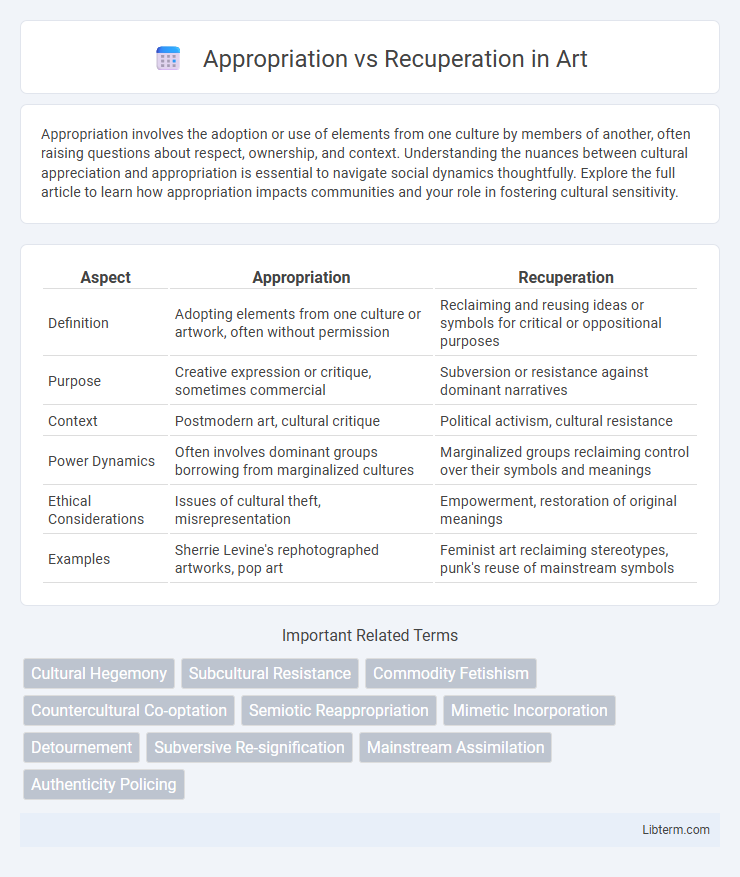Appropriation involves the adoption or use of elements from one culture by members of another, often raising questions about respect, ownership, and context. Understanding the nuances between cultural appreciation and appropriation is essential to navigate social dynamics thoughtfully. Explore the full article to learn how appropriation impacts communities and your role in fostering cultural sensitivity.
Table of Comparison
| Aspect | Appropriation | Recuperation |
|---|---|---|
| Definition | Adopting elements from one culture or artwork, often without permission | Reclaiming and reusing ideas or symbols for critical or oppositional purposes |
| Purpose | Creative expression or critique, sometimes commercial | Subversion or resistance against dominant narratives |
| Context | Postmodern art, cultural critique | Political activism, cultural resistance |
| Power Dynamics | Often involves dominant groups borrowing from marginalized cultures | Marginalized groups reclaiming control over their symbols and meanings |
| Ethical Considerations | Issues of cultural theft, misrepresentation | Empowerment, restoration of original meanings |
| Examples | Sherrie Levine's rephotographed artworks, pop art | Feminist art reclaiming stereotypes, punk's reuse of mainstream symbols |
Understanding Appropriation: Definitions and Contexts
Appropriation involves the intentional adoption or use of elements from one culture by another, often raising issues of power imbalance and cultural sensitivity. In art and social theory, it is examined as a practice where dominant groups borrow from marginalized cultures, sometimes leading to misrepresentation or exploitation. Understanding appropriation requires analyzing historical contexts, intent, and impact to differentiate it from respectful cultural exchange.
What is Recuperation? Key Differences Explained
Recuperation refers to the process by which radical or oppositional ideas and practices are absorbed and neutralized by mainstream culture or institutions, often losing their original critical edge. Unlike appropriation, which involves borrowing elements from a culture, recuperation reframes these elements to align with dominant ideologies, effectively neutralizing resistance. Key differences include the intent and outcome: appropriation may exploit cultural symbols superficially, while recuperation systematically transforms subversive messages into tools supporting the status quo.
Historical Examples of Cultural Appropriation
Historical examples of cultural appropriation include Western artists adopting Indigenous motifs without permission, such as Pablo Picasso's use of African tribal masks, which perpetuated power imbalances and erased original cultural significance. Colonial-era exhibitions often displayed non-Western artifacts as exotic curiosities, reinforcing stereotypes and exploiting marginalized cultures. These instances highlight how appropriation extracts elements for aesthetic or commercial gain while ignoring the heritage and rights of the source communities.
Cases of Recuperation in Social Movements
Cases of recuperation in social movements involve dominant systems absorbing radical ideas or symbols to neutralize dissent and maintain control without addressing underlying grievances. Examples include the commercialization of countercultural symbols in consumer markets and the co-optation of protest language by mainstream political campaigns. This process undermines transformative potential by diluting original meanings and redirecting activism into institutional frameworks.
Power Dynamics in Appropriation and Recuperation
Power dynamics in appropriation involve dominant groups exploiting cultural symbols, practices, or knowledge from marginalized communities without permission or equitable recognition, reinforcing systems of inequality. Recuperation, by contrast, refers to the process where subversive or marginalized cultural elements are co-opted and normalized by dominant powers, often neutralizing their original radical intent. Both dynamics reveal how cultural expressions become sites of struggle over control, representation, and the legitimacy of meaning within societal hierarchies.
The Role of Media in Shaping Narratives
Media plays a crucial role in shaping narratives by mediating the tension between appropriation and recuperation, often framing cultural symbols either as exploitative acts or as acts of cultural revival. The representation of marginalized groups in mainstream media can either reinforce stereotypes through appropriation or empower communities through narratives of recuperation that reclaim and redefine cultural identities. How media outlets select, amplify, or silence specific voices directly influences public perception and the ongoing cultural discourse surrounding authenticity and ownership.
Ethical Considerations and Controversies
Appropriation involves adopting elements of one culture by another, often raising ethical concerns related to consent, respect, and power imbalances, especially when marginalized groups are involved. Recuperation refers to the process by which radical or subversive cultural expressions are absorbed and neutralized by mainstream or commercial forces, sparking controversy over authenticity and exploitation. Ethical considerations in both cases underscore the importance of cultural sensitivity, acknowledgment, and the potential impact on original creators and communities.
Impact on Marginalized Communities
Appropriation often exploits marginalized communities by stripping cultural symbols of their original context, leading to erasure and misrepresentation. Recuperation, while reinterpreting these symbols, can reclaim power and foster visibility within dominant discourses. The impact hinges on who controls the narrative; marginalized voices benefit when recuperation centers their perspectives, whereas appropriation tends to reinforce systemic inequalities.
Strategies for Respectful Cultural Exchange
Appropriation involves taking elements from a culture without permission, often leading to misrepresentation and harm, while recuperation seeks to reclaim and restore cultural meaning through respectful engagement. Strategies for respectful cultural exchange include active collaboration with cultural custodians, proper attribution, and understanding the historical and social context of the exchanged symbols or practices. Emphasizing education and open dialogue helps foster mutual respect and prevents exploitative or superficial usage of cultural elements.
Moving Forward: Fostering Inclusivity and Understanding
Appropriation often involves adopting elements of marginalized cultures without proper respect or context, leading to misrepresentation and harm, while recuperation seeks to reclaim and empower those cultural elements within their original communities. Moving forward, fostering inclusivity requires active dialogue, education, and collaboration to honor cultural significance and promote mutual respect. Emphasizing cultural appreciation rather than appropriation creates a foundation for deeper understanding and authentic connections across diverse groups.
Appropriation Infographic

 libterm.com
libterm.com